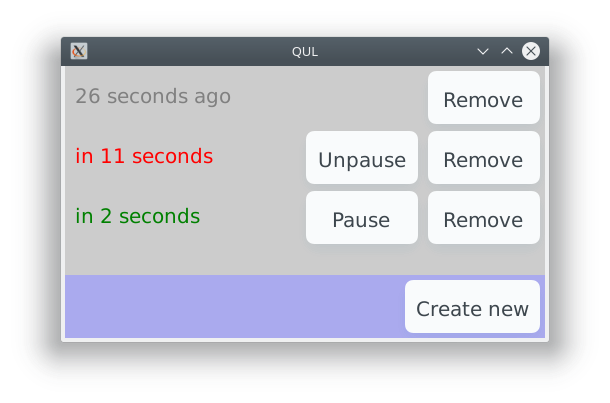C
Qt Quick Ultralite listmodel Example
Demonstrates how to create mutable list models.
Overview
The example shows how to make a mutable model using Qul::ListModel. The model is used in a ListView to build a minimal alarm application.

The example shows a list of alarms that can be paused, resumed, and removed. The Create new button adds a new alarm on every selection.
Target platforms
Project structure
List model
The mylistmodel.h file defines the list model.
First, it declares the list element data type:
// To create a custom ListModel<T>, we need to declare a type T that holds // the data for each element and is equality comparable. // // Here, the data type is AlarmData and it holds the number of seconds before // the alarm should trigger (negative if it has already triggered), as well // as a running flag. //! [ListModel data] struct AlarmData { AlarmData() : seconds(0) , running(false) {} AlarmData(int argSeconds, bool argRunning) : seconds(argSeconds) , running(argRunning) {} int seconds; bool running; }; inline bool operator==(const AlarmData &lhs, const AlarmData &rhs) { return lhs.seconds == rhs.seconds && lhs.running == rhs.running; }
Then the AlarmModel is implemented based on ListModel<AlarmData>:
// Declare our AlarmModel. // // The only requirement is that we implement the pure virtual functions // count() and data() from ListModel. // // We add the other functions to allow our UI to affect the model. //! [custom ListModel] struct AlarmModel : Qul::ListModel<AlarmData> { private: Qul::DynamicList<AlarmData> m_data; public: // Implement the ListModel interface int count() const QUL_DECL_OVERRIDE { return m_data.count(); } AlarmData data(int index) const QUL_DECL_OVERRIDE { return m_data[index]; }
The model also contains functions for modifying the model from QML, like the addEntry() function.
void addEntry(int seconds) { m_data.append(AlarmData(seconds, true)); modelReset(); }
List view
The ListView in listmodel.qml needs the AlarmModel, an instance of which is created as a child of the root object:
// Create an instance of the custom AlarmModel AlarmModel { id: alarmModel }
The ListView uses the model instance to fill the alarmDelegate with data:
// This ListView is the main display element. It creates an alarmDelegate // instance for each entry in alarmModel and listens to alarmModel changes. ListView { width: parent.width anchors.top: parent.top anchors.bottom: controls.top model: alarmModel delegate: alarmDelegate }
When the Create new button is clicked, a function on the model is called to add a new alarm:
Button { id: createNewButton text: "Create new" anchors.right: parent.right onClicked: alarmModel.addEntry(15) }
Delegate
The delegate controls the look-and-feel of each entry in the ListView based on the data from the model.
// Declare the delegate that the ListView (below) instantiates for each // entry in the alarm model. // // It shows information about the entry and two buttons, one to pause or // unpause the alarm, and one to remove it from the list. Component { id: alarmDelegate Item { width: root.width height: 60
For example, the state and labels of the buttons on each alarm is defined like this:
Row { anchors.right: parent.right Button { text: model.running ? "Pause" : "Unpause" visible: model.seconds > 0 // The "index" property contains the model index for // the current delegate instance. onClicked: alarmModel.togglePause(index) } Button { text: "Remove" onClicked: alarmModel.remove(index) } }
Files:
See also Qul::ListModel and ListView.
Available under certain Qt licenses.
Find out more.

